Adrian Collins's Blog, page 192
December 17, 2020
REVIEW: This Virtual Night by C.S. Friedman
This Virtual Night is C.S. Friedman’s long-awaited sequel to her 1998 cyberpunk success, This Alien Shore. The speculative fiction author’s latest space opera, second in the Outworlds series, has a brand new cast of characters and is set in the same fascinating universe of mutated humans and bustling intergalactic trade, approximately 20 years after the events of This Alien Shore.
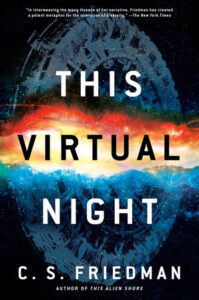 This Virtual Night opens from the perspective of young players of an engrossing medieval virtual reality game that is superimposed on the real world. Just as the reader starts to empathize with these characters, the first chapter comes to an explosive end. We discover that the players were somehow manipulated in-game into performing an attack meant to destroy the life support system of a major space station. Two unlikely allies, mercenary explorer Ru Gaya and out-of-his-depth game developer Micah Bello, must discover how and why the attack happened. The two chase the trail from an abandoned station infected with insanity to a chaotic outlaw stronghold in the hopes of stopping a mysterious entity capable of altering people’s perception of reality: a capacity that could bring the destruction of outworld civilization.
This Virtual Night opens from the perspective of young players of an engrossing medieval virtual reality game that is superimposed on the real world. Just as the reader starts to empathize with these characters, the first chapter comes to an explosive end. We discover that the players were somehow manipulated in-game into performing an attack meant to destroy the life support system of a major space station. Two unlikely allies, mercenary explorer Ru Gaya and out-of-his-depth game developer Micah Bello, must discover how and why the attack happened. The two chase the trail from an abandoned station infected with insanity to a chaotic outlaw stronghold in the hopes of stopping a mysterious entity capable of altering people’s perception of reality: a capacity that could bring the destruction of outworld civilization.
The novel is in tight third person with alternating point of view chapters. There are two characters whose perspectives we see most often: Ru and Micah. Ru is a Gueran outrider—an explorer whose risk-loving Variation makes her perfect for seeking far-flung inhabited worlds—who has been hired covertly to investigate the incident. Micah is a renowned VR game designer and coder of some skill who must clear his name by finding the group responsible for the attack.
This time around, Friedman’s main characters feel more engaging than those from This Alien Shore, perhaps because they hew more closely to familiar sci-fi archetypes or simply because Friedman has matured as a writer. Though we know very little of their pasts, Ru and Micah’s actions clearly demonstrate their strong character. Their interactions and deepening relationship unfold organically, in direct comparison to the first book’s depictions of relationships as a means to an end. The two also have an interesting dynamic with the scarred and self-interested character Ivar.
Friedman’s sequel further explores a huge and textured setting and investigates the concept of a technology that connects directly to the human brain. In This Alien Shore, Friedman asks what a computer virus could become in a world where it could affect the human mind. This Virtual Night examines where the threshold between reality and virtual reality should be defined when virtual reality is directly interfacing with the human brain.
“What is reality, if not shared illusion?”
This Virtual Night deals with the classic literary theme of illusion versus reality through the exploration of virtual reality. The characters in the novel often literally cannot trust what they see and hear due to the external manipulation of software connected to their brains. It would be nearly impossible to navigate a world supplanted by fiction. Today’s social technology has already proven itself capable of flooding the internet with misinformation and manipulating public opinion. Misinformation has the capacity to alienate people from one another. Fear of the other is used to dramatic effect throughout Friedman’s Outworlds series, where humanity’s great diaspora throughout the stars and subsequent mutation and fragmentation leads to marked xenophobia. Characters already fear one another based on insignificant details, so if VR technology overlays a false reality, this fear can and does explode into violence.
“Each human is, within himself, an alien landscape to all others.”
At its core, This Virtual Night feels like a classic space opera adventure, in contrast to This Alien Shore’s zigzaggy cyberpunk thriller. The book has a certain romance about it that aligns with many space opera tropes we know and love: the battles are epic in scope, the heroes and villains larger than life, the settings fantastical, and the people often irresistibly good-looking. One gripe concerns the ending of the novel, which felt a little too neat. Loose ends are tied up, and our heroes essentially save the day and then ride off into the sunset.
Though not required, it is highly recommended to read the first book in the series to fully enjoy the nuances of This Virtual Night. Fans of Neal Stephenson, William Gibson, and Anne Bishop should check out Friedman’s work.
C.S. Friedman knows how to craft a solid science fiction novel. This Virtual Night is a fast read due to deft pacing, a fun plot, and skillful world building. Held up to its predecessor, This Virtual Night’s more conventional concepts might not stick in the recesses of the mind quite as effectively. But with everything going on right now, maybe it’s okay to lose yourself in a sci-fi adventure rather than ponder deep philosophical implications of advancing technology.
4 stars.
Read This Virtual Night by C.S. Friedman
The post REVIEW: This Virtual Night by C.S. Friedman appeared first on Grimdark Magazine.
REVIEW: “The Expanse” Series Five Episodes 1-3 Reaction
For the uninitiated, “The Expanse” is a science fiction TV series that is now in its fifth season with at least one more to come via Amazon Prime. “The Expanse” is inspired by the series of the same name by James SA Corey (pseudonym of writing duo Daniel Abraham & Ty Franck.)
We’ve covered the previous events in the TV show previously (Link) but as this is the fifth season, I’d strongly recommend checking the previous ones out rather than jumping in cold.
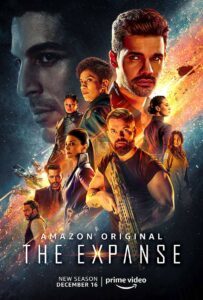 Those of us who are fans of “The Expanse” have been eagerly awaiting the new series for some time after the tantalising hints at the end of the fourth season and we’ve been rewarded with three episodes on release day.
Those of us who are fans of “The Expanse” have been eagerly awaiting the new series for some time after the tantalising hints at the end of the fourth season and we’ve been rewarded with three episodes on release day.
Rather than doing a beat-by-beat recap, I’m going to do a quick rundown of significant events in each episode for each plot thread/location and then discuss the things that really stood out to me over these episodes. Buckle up.
Episode One
The episode kicks off with one of the asteroids that Marco Inaros sent on a collision course with Earth passing too close to the Sun and shattering. Later, a science vessel over Venus is investigating the rogue asteroid when it gets attacked and destroyed by the Free Navy, under the command of Filip Inaros – Marco Inaros & Naomi Nagata’s son.
Naomi
On Tycho station, Naomi is talking with Belter mech Sakai and asks her not to use pejoratives against Martians before butting heads with Bull over the Rocinante’s preferential treatment. Fred Johnson then meets Naomi and advises her that her son is alive and still affiliated with Inaros.
Naomi later discusses this with Holden, who wants to come and help but Naomi explains that Holden would make things harder and she has to go alone. She had to try and save him from the fate that being associated with Inaros makes almost inevitable.
Holden
Tired of news about the Rings and their Builders, Holden switches the news off then goes for a drink. He is then pressured by Monica – the journalist from season three – who has had a shift in personality and is now driven to seek out the shadowy forces manipulating things. She says that people are still trying to get the protomolecule. Holden tells her to go away, but then goes straight to Fred Johnson to ask about it.
Despite Holden telling him about the hostile entities that eliminated the Builders and revealing that Holden perceives them as getting angry at the renewed use of the Rings, Johnson says he cannot give up the Belt’s protomolecule until they are patrolling their territory without assistance. Johnson then makes an interesting point that Holden should concentrate on his blessings – his relationship with Naomi, his ship, his crew – rather than the ‘end of the world.’
Amos
– En route to Earth, moves to the lower decks ostensibly to avoid snoring. He then stands up for new bunkmates in the face of a protection racket. He almost immediately goes for a shower with his new bunkmates asking if he knows what will happen. “I don’t like to wait.” Of course, Amos beats up the protection racket gang and then has a shower. Arriving on Luna he gets stopped by two cops and immediately reacts with “First of all, I didn’t start it and they were all alive when I walked out.” It turns out they’re taking him to Avasarala who greets him with “You look like shit.’ Avasarala wants to know if Amos is going to Earth

Bobbie & Alex
– Bobbie is working for Avasarala, trying to get info on the black market smuggling on Mars. She burns a contact and decides to ask Avasarala to finance a big purchase to flush out a major player.
Alex returns to Mars and sees adverts for work on off-world colonies on his way to visit his wife. She wants no part of him and that she doesn’t owe him closure. OUCH. Alex is in contact with his son, but the call is super awkward.
Alex meets Bobbie, who claims to be unemployed. Bobbi is in no mood for Alex’s hopefulness regarding his family or Mars in general and is pretty blunt with him.
Avasarala
– After meeting Amos, an admiral comes to tells Avasarala that the science ship on Venus *might* have been destroyed by Inaros.
As the episode ends, Holden is alone and maudlin on the Roci, Alex sees boarded up shopfronts on Mars, Amos lands back on Earth and Inaros watches the progress of his asteroids.
Episode 2
Drummer
– Drummer has resigned from the OPA and is now running as a pirate. She finds Ashford’s ship.
Amos
– Amos has returned to Earth after the death of the woman who effectively raised him. It’s revealed that this woman, Lydia helped to anchor the young boy – whose real name is Timothy – after being a bad person herself – probably a prostitute and/or madam. It ends up being revealed that Amos was himself a child prostitute before he got too old and became muscle himself.
He meets Lydia’s partner, Charles who is now being evicted as the man who owns the house – Eric – wants it back.
Amos goes to meet Eric and punches one of his pimps/dealers to get him to pass on a message. When the guy returns to take Amos to Eric, Amos passes him some ice. No hard feelings.
Meeting Eric, it is revealed that Amos – actually Timothy – and Eric were street rats together and Timothy killed the real Amos Burton and took his identity as a way off world, while Eric took over the business in Baltimore.
Eric thought Amos was actually intending to ‘come back’ but Amos is at pains to say he’s not here to take anything that belongs to him, just to make sure that Charles gets to stay in Lydia’s house. Eric says ‘you’ve changed.’
Eric says that Burton’s ID won’t hold up if he is arrested. He also says “I love you, but show your face in my city again and I’ll put you down.”
We get a memory of Amos as a child with a bloodstained face, looking out to sea with Lydia. They deciding to make a better life where they pretend they aren’t such bad people.
Later, Amos is on the same dock at night when a bunch of young hoods wander up to him. Amos frightens them off, then makes a call – he has one more person to see before he leaves Earth forever.
.

Holden
– Monica contacts him again and says she has info about the protomolecule and wants to meet but she is not there when he goes to meet her and her apartment has been turned over.
Holden takes the issue to Fred Johnson, but the footage from the hall has been deleted. We see Monica captive inside a cargo container. She tries to escape but ends up denting the door and venting her atmosphere as she’s being stored in space. In the nick of time, Holden & Johnson managed to find her.
Alex & Bobbie
– Alex goes to visit Bobbie and she apologises and lets him know what she’s doing. Bobbie has an idea about who’s at the top of the black market – Admiral Sauveterre- but she can’t get close. Alex says he can speak to him.
Alex goes to see the Admiral after a military strategy lecture. Sauveterre makes a stirring speech about making bold moves without analysing every possible action. Everything that happens alters the strategic framework – the ring space has changed everything. To carry the dream of Mars to a dream of humanity around 1000 stars.
The Admiral gives Alex short shrift – he is, after all, piloting a stolen Martian ship for an Earth captain. Lieutenant Babbage then speaks to Alex and arranges to meet him, but she is working for the Admiral.
Avasarala
– Crisjen has a difficult chat with her daughter who is visiting her on Luna. They deal with Avasarala’s estrangement from her husband and decision to remain politically engaged rather than retire and spend more family time. Avasarala later speaks to the UN council regarding the possibility of Inaros being involved with Venus but gets shut down by her successor. Later she speaks to UNN Admiral Delgado about why the science ship might have been destroyed as it is strange for Belter pirates to operate in the inner system.
Avasarala & Delgado get a scientist in to look at asteroid data and it comes to light that the string of asteroids could be one larger one that had broken up due to gravity and for some reason, the asteroids have a strange reflectivity. On the assumption this means that the original asteroid was coated in Martian stealth tech, Avasarala wants the Watchtowers usually looking at Mars to be reassigned.
Episode Three
Drummer
– Camina finds Ashfords ship and his data cores. She tells her pirate crew that she plans to collect the bounty on Inaros. For the money, obviously. Not vengeance. It’s totally vengeance. Camina is later comforted by a crewmate.
Holden
– Monica shows evidence that Cortisar – the protomolecule scientist from series one – has been abducted. Sakai helps Holden & Johnson find out who bought the container Monica was in, but the two Belters have already been assassinated.
Naomi
– On Pallas station, Naomi gets heckled by Belters jealous of her money but she is saved by old pals who are happy to see her, but also still bitter that she left them. They warn her off trying to ‘save’ Filip.
Later, Naomi confronts her son and it doesn’t go well. He’s righteously angry that she left him and is now with an Earther, flying with other Inners.
He comes to her later in her ship, but she is attacked by her old friends and they steal her ship. Her friends are going to leave her on the station but Filip says she’s coming with them.
Alex & Bobbie
– Alex tells Bobbie how his meeting with the admiral went and she is still sure he’s the guy they’re after. Alex goes to meet Lt. Babbage and has a very awkward and cringy pseudo-date with her. As he gets home, he gets jumped and interrogated as to why he’s interested in the admiral. Bobbie arrives and beats up his attackers, who are then taken away by Martian police. They decide to follow the resulting lead using Alex’s yacht and polluting skills, although Alex is wary that this ship doesn’t have any weapons.
 Avasarala’s – Delgado visits and says he was shut down when asking about the Watchtowers and that he can’t help Avasarala anymore. She says he’s her last ally. She later receives the information Drummer recovers from Ashford, indicating he was planning to do something grander with asteroids.
Avasarala’s – Delgado visits and says he was shut down when asking about the Watchtowers and that he can’t help Avasarala anymore. She says he’s her last ally. She later receives the information Drummer recovers from Ashford, indicating he was planning to do something grander with asteroids.
Too late.
Last thing we see in this episode is an asteroid crashing down towards Africa. An old man is fishing. The horizon lights up.
Thoughts
There is a lot of significant character work going into these three episodes as the tension was built up towards the first asteroid impact on Earth. There are three main threads I want to talk about.
Belter Culture
There is so much interesting stuff with Belter culture in these episodes. Starting with Sakai calling a Martian a ‘duster’ and Naomi asking her not to use slurs against inners, seeing as the rest of the crew are inners and they all work together. The attitude between Sakai and Bull later on Tycho also plays up to this tension. Then we see Naomi ostracised by her fellow Belters, including her friends and son due to her association with Inners. There’s some excellent code-switching between English and Lang Belta from Naomi, especially in the bar on Pallas that shows how she walks between two cultures and not easily or comfortably.
On Drummer’s ship it’s implied that the pirates are polyamorous and bisexual, which makes a lot of sense in how relationships would need to be conducted in close confines on long journeys. The sense of sharing and community in place of more restrictive moral codes you might expect from an Inner ship, all discipline and hierarchy. There is also the fact that Camina takes the killing of her friend, Ashford – who was her enemy in the not too distant past – very personally and this speaks to codes of honour and obligation amongst the Belters.
Finally, there are very convincing arguments put forth by many Belters that show how deep the resentment against the Inners is and how appealing Inaros grand ambitions are. From Sakai’s interaction with Bull all the way to Filip actively repudiating his mother, this is emotive and embedded stuff.
Amos / Timothy
Especially in the second episode, there is so much awesome content around Amos here. The revelations about his real identity, his childhood and so on are massive and offer an insight into a previously enigmatic character.
The dichotomy in Amos’s character is remarkable. He seemingly seeks a dangerous brawl with a gang en route to Earth for the sake of it but will take risky action to protect a man he’s never met before in the name of a dead woman who was kind to him.
I’ve always been a huge fan of Amos’s directness and the implied neurodivergence in his character but this season is taking that to a whole new level.
Mars
At the start of the series, Mars was a superpower, going toe to toe with Earth and a real threat to the homeworld. Since the Ring gates have opened up the universe, the long hard work of terraforming is not as appealing as just moving to a habitable world and Mars is bleeding.
Alex is shocked to see the way the planet has gone from a bustling hive of industry, with work always available to what feels like a ghost town.
This has led to the black market, with Mars much-vaunted technology now being sold off to the highest bidder. I also find Admiral Sauveterre’s speech about the importance of the Ring space and taking the dream of Mars from one dusty rock around a single star to 1000 systems to feel like a foreshadowing of something hegemonic.
Would a Martian faction deliberately work with Belters to hobble Earth while actually seeking Empire among the stars?
Grimdark though?
Oh yes. This season of “The Expanse” has already had plenty of grimdark elements. We see inequality and corruption on Mars. We see our protagonists having difficult relationships where their good intentions simply don’t fix things. We see the effect of centuries of embedded exploitation, colocalization, and prejudice, resulting in terrorism on a grand scale. We see that even on rich, shiny homeworld Earth, there are still places where people have to sell their bodies for drug money, run by exploitative and morally bankrupt people. We see a broad range of people making bad choices from worse options with few good outcomes seeming possible.
In my eyes, “The Expanse” is exceptional science fiction as it twists real-world issues through just enough of a speculative lens to balance out the hard truths with enough distance and pretty visuals to stop us from turning away. It allows us to ask questions about what is morally right with choices so bad and what would we do in that situation.
In previous seasons we had inciting incidents such as the destruction of an ice hauler, the creation of the Ring gate, and now after three episodes of character work and build up, we just saw an asteroid dropped on planet Earth. I can’t wait for what comes next.
Episodes 1-3 of Season Five of “The Expanse” can be streamed via Amazon Prime – https://www.primevideo.com and new episodes are coming every Wednesday.
The post REVIEW: “The Expanse” Series Five Episodes 1-3 Reaction appeared first on Grimdark Magazine.
December 16, 2020
REVIEW: This Alien Shore by C.S. Friedman
C.S. Friedman recently released a somewhat unexpected sequel to her 1998 novel This Alien Shore last month: This Virtual Night. This Alien Shore is C.S. Friedman’s most successful science fiction work and was listed as a New York Times Notable Book of the Year. Rereading the first book in the series through a modern lens and with the benefit of hindsight reveals that This Alien Shore remains an undeniably good science fiction novel. Friedman’s thorny concepts and compelling technological ideas make the book feel fresh and relevant.
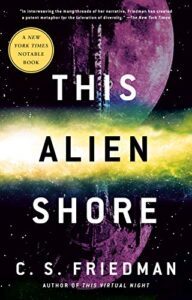 This Alien Shore explores a universe in the second stage of human space colonization. Humanity’s first attempt to colonize distant space ended catastrophically, with the first wave of colonists experiencing permanent genetic damage, resulting in physical and mental mutations known as Variations. The Outspace Guild, which was created by Guerra, one of the first colonies, now controls interstellar travel through tight control of an alternative method of faster-than-light travel that only they are capable of providing. All humans have a built-in interface between mind and machine that allows them to access the outernet. A deadly digital virus is targeting Guild members, and reclusive Dr. Kio Masada is tasked with finding it and neutralizing it before it spreads to the entire human race. Meanwhile, the young Jamisia is being hunted ruthlessly as a valuable commodity for what’s inside her head. She has been experimented on without her knowledge or consent, leading to an acute form of multiple personality disorder that might just challenge the status quo of space travel.
This Alien Shore explores a universe in the second stage of human space colonization. Humanity’s first attempt to colonize distant space ended catastrophically, with the first wave of colonists experiencing permanent genetic damage, resulting in physical and mental mutations known as Variations. The Outspace Guild, which was created by Guerra, one of the first colonies, now controls interstellar travel through tight control of an alternative method of faster-than-light travel that only they are capable of providing. All humans have a built-in interface between mind and machine that allows them to access the outernet. A deadly digital virus is targeting Guild members, and reclusive Dr. Kio Masada is tasked with finding it and neutralizing it before it spreads to the entire human race. Meanwhile, the young Jamisia is being hunted ruthlessly as a valuable commodity for what’s inside her head. She has been experimented on without her knowledge or consent, leading to an acute form of multiple personality disorder that might just challenge the status quo of space travel.
The universe of This Alien Shore is a high tech, highly fragmented society with intensely competitive players. At the beginning of the novel, Jamisia’s space habitat is completely destroyed by corporate raiders, killing a significant number of people. “Somewhere on the habitat real damage had been done, probably in the name of some corporate maneuver […] capitalism is a harsh mistress.” The Guild, meanwhile, has its fingers in nearly every aspect of commerce among the stars. Friedman’s Guild draws parallels to Frank Herbert’s Dune, where the Spacing Guild also has a stranglehold on space travel through proprietary navigators—though perhaps with fewer good intentions than Friedman’s.
This Alien Shore aptly distills fears of the future of internet privacy and anti-corporate sentiments that are increasingly pertinent now. Friedman forecasts many costs and corresponding benefits for a society driven by connection technology. Written before the advent of Google and Facebook’s data supremacy and those handy little tracking devices we carry around in our pockets, the novel was published right in the midst of the dot com bubble. Though at the time, digital advertisement was in its infancy, Friedman correctly guessed how prevalent predatory advertisement strategies would get. The concept of a deadly virus taking over the world feels especially apropos.
This Alien Shore contains some interesting, capable, and nuanced neurodivergent point-of-view characters. Friedman’s Guerans (part of the first wave of colonists) have a Variation that causes them to exhibit signs of mental illness that were previously eradicated in the general population on Earth. However, this Variation is often portrayed as having net positive effects with Guerans shown to perform at a much higher level than neurotypical humans. The esteemed Dr. Masada is portrayed as quite far along the autism spectrum, which allows him to manipulate data and arrive at stunning conclusions as he seeks the dangerous virus. Friedman’s own experience with mental health informs her sensitive exploration of the subject.
One relatively brief scene in the novel aged badly. As Jamisia travels on a space ship, she spies on an isolated sector and learns that Muslims are essentially the only culture that still practices slavery. In Friedman’s depiction of the future, the Islamic practice of pilgrimage to Mecca can be prohibitively expensive enough that some people are willing to sell themselves into indentured servitude. The passage, in its entirety less than one hundred words, could echo anti-muslim feelings in the United States at the time. North American baby boomers like Friedman probably grew up watching decades of strife in the Middle East. From the 1970’s through the 1990’s, Americans witnessed the Arab-Israeli War, oil embargo, Iranian Revolution, Iranian hostage crisis, and the Gulf War in Iraq. Just a few years after This Alien Shore was published, Islamophobia reached a fever pitch with the September 11, 2001 terrorist attack in New York. But in 2020, this passage feels somewhat out of place in a book that otherwise preaches tolerance, and may confound modern readers. Its omission would not have affected the plot.
Upon reading through a more critical and contemporary lens, This Alien Shore still holds up. Themes of human madness and fear of the other are engagingly explored with well-chosen detail and vivid settings. The book ends pretty conclusively, though some questions remain about what might have happened to the main characters after the ending.
4.5 Stars
Read This Alien Shore by C.S. Friedman
The post REVIEW: This Alien Shore by C.S. Friedman appeared first on Grimdark Magazine.
December 15, 2020
Five Reasons To Be Excited About The Expanse Season 5
With Season Five of The Expanse only days away, let’s look ahead at five of the plot threads I’m most excited by for this season. As with yesterday’s post, if you aren’t up to Season 5 in either the movies or the books, now is the time to bail out of this article–head over to our catalogue or something less spoilery.
1. Deep Impact
At the end of Season Four, we saw Belter terrorist/freedom fighter Marco Inaros setting multiple asteroids on collision courses with Earth. If one or more of those land, it’s going to cause massive devastation and have far reaching implications for the power balance in the solar system and beyond. Given Inaros’ speech and Amos’ decision to return to Earth from the Season Five trailer , I’d guess that at least one asteroid landed.
2. Dream Over
For the first three seasons, Mars was presented as a near-monolithic culture, breaking free from Earth’s hegemony through technological innovation and hard, unified effort. However, the advent of the Ring and the opening up of a thousand new systems has dented that resolve, with many Martians not seeing the point in backbreaking labour for their great great grandchildren to see water on Mars, when they can just hop on through the gates to readily colonisable worlds.
This has lead to black market trading of Martian technology and a sudden loss of manpower on the red planet. Bobbie Draper uncovered some very sketchy stuff over Season Four and with Inaros’ Belter faction getting more aggressive, Mars seems to be teetering from stable and ambitious superpower to a fragile powderkeg.
3. Blood Runs Thicker
As Inaros was sending irascible old Klaes Ashford into space, standing beside him was Filip, his son by former flame and now member of the Rocinante crew, Naomi Nagata. From the season five preview, we know that Naomi is now aware of her son’s survival and allegiance to Inaros and is planning to reconnect with/rescue him. I expect this to be a straightforward process.
4. A Thousand Worlds
Most of Season Four was concentrated on the world of Ilus, through one of the 1,372 systems made accessible through The Ring. This world was contested between a group of Belter refugees from Ganymede – who got there first – and an official sanctioned colonising group from Royal Charter Energy.
This tense situation was further complicated when Holden & the Investigator managed to activate some Ring Builder technology on the planet (we’re getting to that) but it’s likely that even without that escalation, the conflicts between such groups will play out across the quickly spreading human diaspora.
5. Apocalyptica
On top of the very human stories of the Rocinante crew and the political machinations between the powers in our solar system, there is the wider meta-story which started with the protomolecule and has led to humanity spreading out across the universe.
The protomolecule was discovered on Phoebe and generally misused by corporate and political interests. It was thought to be a natural substance or an alien weapon, but what it actually is is a mechanism by which the Ring Builders attempted to seed systems with Rings to access their network.
As such, once the protomolecule had time, energy and resources to develop on Venus (having been dormant for millennia since it was captured by Saturn’s gravity and became Phoebe), it created the Ring which gave our solar system access to the Ring Network.
However, it turns out that since the protomolecule was sent towards our system at sub-light speeds, the Ring Builder’s civilisation has vanished. It appears they were annihilated by an as-yet unidentified threat, and the protomolecule wants to find out about that, so has set the Investigator as a passenger in Holden’s brain for that purpose.
Given that humanity is enthusiastically spreading across the ring network and carrying all the baggage of vendetta, colonialism and greed with us, I’m sure we’ll find out about that soon enough.
Throw all of that on top of the always entertaining interplay of the main characters, standout performances by the actors and the best space physics ever seen in a major sci-fi series and I’m really excited for this season of The Expanse.
Season Five of The Expanse debuts its first three episodes on Amazon Prime on December 16th.
Grab your Amazon Prime membership to watch The Expanse Season 5 and seasons 1-4.
The post Five Reasons To Be Excited About The Expanse Season 5 appeared first on Grimdark Magazine.
ANNOUNCEMENT: Open Submissions for #27 Coming Soon!
The horror and grimdark genres are like the two cousins who sneak away from parties to set fire to things. These genres often go hand in hand, such as in books like The Aching God by Mike Shel or The Ballad of Black Tom by Victor LaValle. These books have fantasy and horror elements that mash together to create grim stories that cant be classified in either genre.
With that in mind, GdM is doing a horror / grimdark SFF crossover for our July 2021 issue. Already we have a commitment from horror master Paul Tremblay for an interview and will be adding in some great names in the next couple of months.
I am looking forward to bringing this mashup to readers.
WHAT WE ARE BUYING FOR ISSUE #27
For this submittal, we are looking for dark stories that span SFF and the horror genre with elements from each. Thus, this issue will be entirely horror grimdark content-focused. Anything not meeting expectations here will get an auto-rejection–please don’t send stories outside our ballpark.
Our definition of “grimdark” is simply a grim story told in a dark world by a morally grey protagonist. Anti-heroes, antagonists turned protagonists, doing wrong for the right reasons or right for the wrong reasons, showing that evil is a matter of perspective—this is what I’ll be after to sell to our readers. As an SFF publication, we also prefer either medieval fantasy settings or near-to-far future SF settings. Urban fantasy is generally a hard sell. For the horror aspects of the stories, any horror genre will be looked at save for splatterpunk horror.
I encourage submissions from authors from the underrepresented parts of human society. Yours, after all, are some of the most unique stories out there.
Feedback will not be provided on the reasons for stories not being selected. This is to help GdM get through the submissions more efficiently than in previous years.
THE OPEN WINDOW
I hope to purchase between 1 – 2 original stories and 4 reprints. Stories that are purchased will likely be published specifically in the 1st July 2021 issue.
For more in-depth detail on rights and submission, please refer to our submissions page.
The submissions window will open at 00:01 AEST on the 25th January 2021 and close at 24:00 on 27th February 2021. All emails received before and after this time will be deleted without response or consideration.
I can’t wait to see what you lot come up with. Let the grimdark horror begin!
Beth Tabler,
Guest Editor Issue #27
The post ANNOUNCEMENT: Open Submissions for #27 Coming Soon! appeared first on Grimdark Magazine.
December 14, 2020
The Expanse season 5: space opera grimdark fans will love
Based on the acclaimed series of novels by James SA Corey (pseudonym for writing duo Ty Franck and Daniel Abraham), The Expanse has become one of the most popular science fiction TV shows of recent years. Drawing praise for deep and nuanced worldbuilding, realistic portrayal of space physics (up to a point) and a compelling cast of characters, the show survived being dropped by SyFy to be picked up by Amazon on the back of fan support.
Now, with series five (of six) less than a week away, it’s a great time to recap the state of the show’s universe and look at why it’s of interest to fans of grimdark fiction. It goes without saying that if you’re not up to series five of this show or the relevant part of the book, spoilers below. You’ve been warned.
The show embraces shades of grey, with all of our main protagonists being far from noblebright. First the ragtag crew of the dubiously salvaged Rocinante – captain James Holden, engineer (and Holden’s romantic better half) Naomi Nagata, engineer Amos Burton, and pilot Alex Kamal who are respectively a dishonourable discharge from the navy, a former terrorist, an absentee father, and severely lacking in social graces. Supporting them is the politically astute former Secretary General of the UN, Chrisjen Avasarala and Bobbie Draper, a former Martian marine who falls in with black marketeers. They’ve all made and are willing to make the tough and bad choices.
There’s also the personality of a jaded Ceres policeman–Josephus Miller—riding in Holden’s head as the Investigator of the protomolecule, looking to find out who destroyed the universe well before humanity re-populated our small corner of it.
The personal choices and relationships of these characters are a delight to watch with standout performances from all the actors. Holden and Naomi’s relationship is strained by their differing influences, Alex tries to keep the group together, and Amos veers between trying to make his own decisions and deciding it’s best if he uses Naomi as a moral compass, lest he beat up the wrong person again.
Elsewhere, Avasarala’s attempt to hold things together on Earth while Bobbie dealing with her illusions about Mars being broken down and the tense relationship between Belters like Camina Drummer, Klaes Ashford, Anderson Dawes are all fascinating and enthralling.
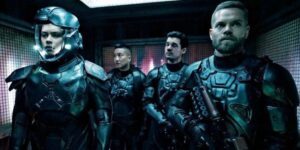
Despite technological advances, the universe of The Expanse is not kind. This is not Star Trek with its post scarcity societies or Star Wars with physics breaking lightspeed for all and space wizards. Earth is corrupt, overpopulated, polluted, and profoundly unequal, with the majority of the population barely getting by on a below subsistence handout called Basic. Earth is also at loggerheads with its former colony on Mars, now the Martian Congressional Republic. Mars has a dream of a terraformed planet and has funnelled that dream into technological advancement and a fantastically devoted populace, committed to service and self abnegation.
Both of these powers exploit the asteroid belt and outer solar system, largely populated by refugees and pioneers who have developed a distinct culture–Belters. Many among the Belt are unhappy about the domination of the Inners and seek to break free, violently if needs be.
So we’ve got inequality, climate disaster, colonialism, and racism weaved all through our setting, with no clear cut good or bad characters.
 Oh yeah, and there was also a corporate conspiracy to ferment war for profit while using an alien protomolecule to create supersoldiers. That resulted in the destruction of Eros & Phoebe, the near destruction of Earth and ultimately the creation of an alien Ring which allowed wormhole access to 1,372 other systems, albeit at the apparent cost of the possible attention of a hostile alien race.
Oh yeah, and there was also a corporate conspiracy to ferment war for profit while using an alien protomolecule to create supersoldiers. That resulted in the destruction of Eros & Phoebe, the near destruction of Earth and ultimately the creation of an alien Ring which allowed wormhole access to 1,372 other systems, albeit at the apparent cost of the possible attention of a hostile alien race.
Finally, The Expanse is not afraid to have popular characters die–although we’ve not lost any of the main crew yet. We’ve seen Josephus Miller infected by Protomolecule & blown up by a nuclear bomb. We’ve seen former pirate, come good-guy Belter, Klaes Ashford spaced out an airlock for being on the wrong (right?) side of a Belter civil war. Finally or rather first of all, Shed Garvey, one of the original survivors of the Canterbury along with the eventual Rocinante crew got beheaded by a railgun round.
Is that Grimdark enough for you? It gets worse. (Or is that better.)
Season Five of The Expanse debuts its first three episodes on Amazon Prime on December 16th.
Get yourself a Prime membership to check out this amazing SF series.
The post The Expanse season 5: space opera grimdark fans will love appeared first on Grimdark Magazine.
December 13, 2020
REVIEW: Widdershins by Alex Alexander
Widdershins begins in the slums, where we meet our protagonist Niclas. It’s difficult to call him hero, as he’s a pretty simple lad and if we’re being honest, he’s not the sharpest tool in the shed. He means well and tries to do the right thing, but he’s just not cut out for great heroics.
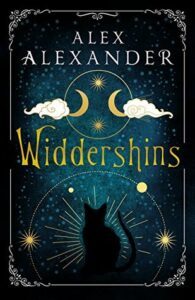 What’s unfortunate for Niclas is that he’s thrust into a series of situations where if he can’t be heroic, at least he is around others that can. The first thing he does is bungle a pickpocket assignment he’s given as a rite of passage into the top slum gang, the Crimson Men. But after he lands in prison, he’s rescued by a talking cat named Balthazar.
What’s unfortunate for Niclas is that he’s thrust into a series of situations where if he can’t be heroic, at least he is around others that can. The first thing he does is bungle a pickpocket assignment he’s given as a rite of passage into the top slum gang, the Crimson Men. But after he lands in prison, he’s rescued by a talking cat named Balthazar.
“It was the first time Niclas had seen a cat smile. The majority of it is in their eyes – their narrow, mischievous eyes.”
The city of Laburnum is ruled by a monarchy, but the real power is the Academy, whose laws are constructed in the interest of logic. It is the Age of Rationalism and the Academy has an Inquisition that stamps out all violations of this idea. The most heinous criminals in the land are guilty of logicide and are locked up in the Academy’s dungeons for all time.
“Anyone who goes widdershins is dubbed a criminal, convicted of logicide and dealt with as swiftly as an itch.”
Widdershins, as explained by Balthazar to Niclas, is simply going against the grain. The clock turning counterclockwise or anyone acting contrary to Logic is going widdershins.
After rescuing Niclas from his dire fate of imprisonment, Balthazar reveals that he has a purpose for this kindness. He needs a manservant, and Niclas is the closest thing he’s found to having one. There are certain things a cat cannot do for himself, as he has no hands. What’s more, most people will rail against the possibility that a cat can talk, and even if they believe it they are then risking their own investigation at the hands of the Academy. After all, the concept of a talking cat goes against all of the principles of logic and reason.
Widdershins also introduces us to the princess of Laburnum, a young woman named Cassandra. She’s a very good student who likes to read almost to a fault. While her scholar encourages her education, Cassandra exceeds expectations and soon learns that reading too much of the wrong kinds of books is a quick way to get into trouble.
“He was usually enjoying a good book. He spent four fifths of his time reading, which didn’t leave a great deal many fifths for much else. But it did make him very smart.”
There is also the Witchhunter in the city, and it doesn’t take him long to catch wind of a talking cat moving around the slums. And as a talking cat would be completely illogical, he determined that it must in fact be a witch in disguise.
Widdershins is a great escape down a dark and dangerous path, where not all is logical or as it seems. This story reminded me quite a bit of Oliver Twist by Charles Dickens, as far as its setting and our main character Niclas. The dark steampunk world gives a great sense of dread, while the hints of magic and wonder behind the curtain of Logic give us hope that it’s not all as bad as it seems. There is a certain lightheartedness to the telling as well, a touch of humor mixed in with the dire circumstances that our characters fall into.
“Some of the stuff people flushed down their water closets was really quite extraordinary.”
It does take a little bit to get the story rolling and all of the characters in place, but once they’re moving it’s a pretty riveting ride. There’s a lot going on beneath the surface of Laburnum, much of it quite literally. The authorities of the Academy would not want these secrets getting out, or it might unravel the entire concept of Logic.
Read Widdershins by Alex Alexander
The post REVIEW: Widdershins by Alex Alexander appeared first on Grimdark Magazine.
December 12, 2020
An Interview with Kristyn Merbeth, Author of the Memoria
Kristyn Merbeth, author of the Nova Vita Protocol novels consisting of Fortuna and the new release Memoria as well as the Wastelanders novels she writes as K.S. Merbeth. Kristyn was kind enough to sit down with GdM and discuss her passion for gaming, story creation, and the ultra-dysfunctional family that is at the heart of the Nova Vita Protocol novels.
GdM: Can you tell our readers a bit about yourself?
I’m the author of the ongoing Nova Vita Protocol series (starting with Fortuna) and, as K.S. Merbeth, the post-apocalyptic Wastelanders books (Bite and Raid). When I’m not writing or reading, I’m often gaming. I also love to cook, make alcohol-infused ice cream, and hang out with my bulldog, Albus.
 GdM: I read that you are a gamer. What games do you play? And what role does gaming play in your life?
GdM: I read that you are a gamer. What games do you play? And what role does gaming play in your life?
Yes! I play all kinds of games – video games, board games, tabletop games. I have a D&D group that has been meeting consistently for about three years now, and some of my recent video game favorites have been Hades and the remake of Final Fantasy 7. Sometimes I game to socialize, and other times to immerse myself in a great story, but, perhaps most importantly, it’s one of the main ways that I can fully relax. It’s hard to turn off my writer brain when I’m doing other things, including reading, but games make it easy to get out of my own head for once.
GdM: What aspects of the science fiction genre attract you to it? What do you see happening to science fiction as a genre in the future?
Writing is often a way of processing and working through anxiety for me. So, I think I’ve always been naturally drawn to a genre that explores possible futures. It helps me approach the kinds of subjects and emotions that scare me without facing them head-on in a way that might be overwhelming.
I imagine I’m not the only one that pours my fears into my writing, which might partially explain why science fiction has been really thriving over the last few years. There has been such an incredible rise of new, diverse voices in science fiction, and some excellent books that have pushed the boundaries of what the genre can be. I look forward to more of that in the future. Bring on the genre-bending weirdness!
GdM: You have written the Wastelanders series and the Nova Vita Protocol, of which Fortuna and your newest book Memoria are a part. Was the process of writing the two series similar?
Writing them was very, very different for me, actually. I’m a pantser at heart, and my instinct is always to jump right in and start writing. That worked well enough with the Wastelanders, but when I tried doing the same thing with Fortuna, I found it impossible. I kept getting stumped by world-building questions and having trouble picturing scenes in a world so very different than ours. Plus, I usually jump around and write scenes non-chronologically, which is tough with multiple POVs. So I had to sit down and do quite a bit more world-building and outlining than usual before I could begin to write.
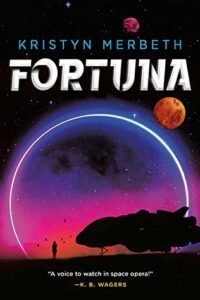 GdM: When you start a book, do you have an end goal in mind for the narrative and characters? Or do you go where the ideas take you?
GdM: When you start a book, do you have an end goal in mind for the narrative and characters? Or do you go where the ideas take you?
I have a sense of where I want the characters to end up, and how I want the ending to feel, but I don’t know everything that will happen along the way. For me, a sense of discovery is the best part of writing, so I like to give myself plenty of room to explore as I go along. And even though I outlined more than usual with this series, on occasions where my outline tugs me in one direction and my heart pulls me in another, I always follow my heart.
GdM: Both your series have to do with family. What family is, specifically for Nova Vita, how a family can mold you. Is this an idea that you gravitate towards?
Absolutely. My family is very important to me; I have two brothers, in particular, that I’m very close with, and I’ve always wanted to write something with sibling relationships at the heart because of that. For many of us, our relationships with our siblings are the longest relationships we have in our entire lives. Years of inside jokes and stupid fights and shared experiences that no one else can ever truly understand. I don’t think I’ll ever get tired of exploring all of the ways in which our families can bring out both the best and the worst in us.
GdM: Can you tell me about the Nova Vita Protocol thus far?
The Nova Vita Protocol is about the Kaisers, a deeply dysfunctional family of criminals who make a living smuggling illegal goods between the five human-settled planets of their system. It’s told from the POV of the two oldest siblings, former “golden child” Corvus who left the ship three years ago to fight in a civil war on his home-planet, and family screw-up Scorpia, who has been struggling to fill his shoes ever since. In Fortuna, a deal gone wrong drags the family into a deadly interplanetary conflict, and forces Scorpia and Corvus to decide the future they want for their family while they grapple with grief and their own strained relationship. In Memoria, the siblings will be faced with the consequences of all of their messy past choices as they discover buried alien secrets and find that interplanetary war, once again, is threatening Nova Vita.
GdM: Memoria is your second book in the Nova Vita Protocol series. What was your experience like writing this one, versus writing the first book Fortuna?
Though I wrote companion novels in the Wastelanders series, Memoria is the first true sequel I’ve written. I was really nervous about it at first! I felt a lot of pressure to do the characters and the story justice. But once I was able to get over those initial nerves, I loved being able to revisit a world and characters that I already knew and cared deeply about. And it also meant I didn’t have to do as much up-front world-building, so I was able to dive right in to the fun part.
GdM: Tell me about the characters Scorpia Kaiser and Corvus Kaiser. I love how Scorpia has “middle child” syndrome. How did you first come to know them?
Some of my first ideas stemmed from their respective roles within the family: Corvus as the responsible oldest sibling and golden child, and Scorpia as the scapegoat and troublemaker. From there, I thought about what kind of people they have had to become in response to these roles – and also, the ways in which they aren’t a perfect fit for them. Both of them are saddled with expectations about who they should be, but Corvus isn’t sure if he can be the person his family remembers anymore, and Scorpia is trying very hard to overcome her past failures. I also considered how they were affected by the shift in the family when Corvus left. Corvus being alone for the first time, no longer defining himself in relation to his siblings and what the family needs from him, and Scorpia suddenly realizing she had a different slot to fill than the one she was accustomed to.
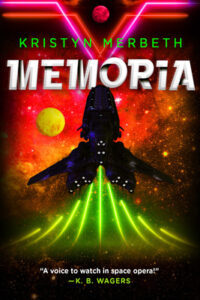 GdM: Both Scorpia and Corvus are developing and coming into their own through Memoria. What do you see for the future of these two characters?
GdM: Both Scorpia and Corvus are developing and coming into their own through Memoria. What do you see for the future of these two characters?
In book three, both characters will be more secure and confident about who they are and who they want to be. I think the series, at its heart, is the story of Scorpia and Corvus discovering themselves in stages, and how the relationship between them shifts in response. In book one, they mainly explore who they are in relation to their family, and their roles within it; in book two, they spend more time exploring who they want to be as individuals; and in book three, they begin to consider their place in the world as a whole, and how they want to be remembered when they’re gone.
GdM: Your battle scenes are exciting! How do you choreograph them? Do you have a set way that you want them to flow, or do you watch it unfold in your head and write down what happens?
Fight scenes are my absolute favorite thing to write! My process usually involves staring at a blank page for an extended period of time, visualizing how I want it to go – and then, the second I figure it all out, I start word-vomiting everything onto the page as fast as possible before it slips away. I’m a very slow drafter otherwise. I jump around chronologically, edit as I go, write “insert description here,” all sorts of bad habits. But I always write out fight scenes, start to finish, without stopping, trying my best to capture the vision in my head.
GdM: Has the last couple of year’s world events affected your characters and writing? I know that Fortuna and probably most of Memoria was written before the Covid virus, but the virus and the xenophobic president Leonis seem almost prescient.
I never sit down with the intent to write about what’s happening in the world, but I think it’s impossible not to live through such tumultuous times and not be affected. Real world events and my feelings about them tend to seep onto the page without me realizing it. But there are also some eerie coincidences. I was just re-reading a scene in book one where the characters go through a sanitation checkpoint on Gaia and everyone is wearing medical masks, which I’m sure some people will assume is a response to Covid, but it was written years beforehand. I suppose part of it might be that I tend to explore worst-case scenarios in my writing, and unfortunately, that has been pretty spot-on for the last few years.
GdM: You have some fascinating world-building in Fortuna and Memoria. How did you go about creating the different settings?
I started with the geography of the various planets, and the difficulties they face. Each planet in Nova Vita has its own fair share of issues to grapple with, from the deadly jungles of Deva to the harsh tundra of Titan. From there, I considered how those challenges might shape them as a society. For example, Titan’s harsh climate and sparse resources have led to an ongoing civil war, which created an intensely patriotic and militaristic culture. On Gaia, a terrible virus years ago has led to deep distrust of the other planets, the everyday wearing of gloves, and greetings that don’t involve touch. I’ve written pages of notes about the different worlds and cultures – things like values, common sayings, architecture, unique laws, main imports and exports – and only a fraction of it ended up on the page, but I think all of it contributes to making each setting feel distinct.
GdM: Finally, a fun question. What is your favorite series? Are you a Star Trek fan, into Star Wars, Battlestar Gallactica, Firefly, or something entirely different?
Ohh, it’s gotta be Firefly! I’m a sucker for charming rogues and, as an Arizonan, I’m very into the western vibes.
Read Memoria by Kristyn Merbeth
The post An Interview with Kristyn Merbeth, Author of the Memoria appeared first on Grimdark Magazine.
December 11, 2020
REVIEW: Cyberpunk 2077
Cyberpunk 2077 is a game that has been hotly anticipated for the better part of nine years. Delayed by both the mammoth juggernaut that was The Witcher 3 and its DLC plus the inability to get it to work on current generation consoles, it was finally released in the tail end of 2020. The people here at Grimdark Magazine were hotly anticipating this game and I had to fistfight the others to see who would get to review it (I’m still looking for my teeth – Ed.).
“Capitalism, capitalism never changes.”
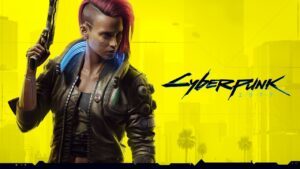 Cyberpunk is the purest expression of the grimdark science fiction series. It combines noir, moral ambiguity, a nihilistic worldview, and genre tropes to create a world where doing good is possible but only on the individual level. Most of its antiheroes don’t even bother with that, only caring about their next paycheck and their partners (if even that). On the Keanu Reeves scale, they tend to be Johnny Mnemonic and John Wick over Neo. Which is good because this game stars Keanu Reeves as your inner Tyler Durden.
Cyberpunk is the purest expression of the grimdark science fiction series. It combines noir, moral ambiguity, a nihilistic worldview, and genre tropes to create a world where doing good is possible but only on the individual level. Most of its antiheroes don’t even bother with that, only caring about their next paycheck and their partners (if even that). On the Keanu Reeves scale, they tend to be Johnny Mnemonic and John Wick over Neo. Which is good because this game stars Keanu Reeves as your inner Tyler Durden.
I’m familiar with the world of Cyberpunk 2077 from my experience with Mike Pondsmith’s Cyberpunk 2020. Crafted in the Eighties, it was never the biggest seller among tabletop roleplaying games but it managed to combine Mad Max, Akira, Blade Runner, Max Headroom: The Series, and a half-dozen other sources to create a fully realized dystopian world that went on to inspire dozens of other settings. If you think about a generic cyberpunk world, as if such a thing could be, you’re probably actually thinking about Mike’s vision as it could do anything from the movies you loved.
A brief rundown for laymen is that the United States has broken up into several new countries due to the collapse of the economy due to a combination of corporate malfeasance as well as depleted resources. Environmental devastation means that much of the Midwest is now ruined wasteland with feuding nomadic clans, cities have become overcrowded urban hellscapes, and corporations now wield the power of nations. Technology has flourished, though, with cybernetics becoming ubiquitous even for healthy able-bodied people and space travel is commercialized.
Cyberpunk 2077 is a future extrapolated from Mike Pondsmith’s future of 2020, not our time so some people may be confused by this. Either way, it is a world that is still relevant due to the fact our 2020 is pretty much a hyper-consequence of the policies enacted in the 1980s. Many of the same greedy materialist corporate executives who rose to power then are still in power today, looting the economy and feeding the masses a steady diet of propaganda.

Cyberpunk is inherently political and this game manages the careful balance of making its points clear while not feeling the need to lecture on what is self-obvious. When you ask whether the marketplace shrimp is fresh and the vendor says, “Absolutely. It’s all raised in the aquarium downtown. None of that toxic crap from the bay.” You know what it’s saying without sounding unnatural. The game touches on everything from for-profit health care, police brutality, corporate malfeasance, rising poverty, defunded social services, and the treatment of sex workers. All within the first few hours and it uses these to tell interesting stories.
The plot of Cyberpunk 2077 is an interwoven set of crime-based stories around a central narrative that is about a miraculous peace of technology gone horribly wrong. I’d call it, “Ghost in the Shell meets Fight Club.“
The stakes are very low in Cyberpunk 2077, at least compared to most Triple A games with it being more science fiction Dragon Age II than Dragon Age: Origins or Inquisition. This is about personal stakes and protecting your small corner of Night City rather than anything world-changing.
Gameplay-wise the game ranges from being excellent to a mess. It basically plays like Skyrim with guns, cyberware substituting for magic. There’s also elements of Deus Ex and Watch Dogs with the ability to sneak up on enemies to auto-kill them or hacking security cameras. Honestly, it doesn’t exactly mold all of these divergent gameplay styles together perfectly but feels more like a Frankenstein’s Monster combination of whatever they thought was cool. There’s just too much going on with looting and shooting, gathering armor types, cybernetics, and hundreds of perks. Gameplay would strongly benefit from being much simpler and closer to Deus Ex or even just the tabletop game.
 The character creation engine is pretty robust with the option of making characters ranging from the absolutely gorgeous to the supremely ugly. Much has been made of the power to make characters of trans identity but this hasn’t been anything new since Saints Row 2. Your pronouns are also tied to your voice, which is a cheap fix that kind of undermines the benefit. Still, I had a lot of fun making Agent G from my cyberpunk novels and playing him. You get to choose an origin for your character but these scenes take about ten minutes to resolve and aren’t really that interesting.
The character creation engine is pretty robust with the option of making characters ranging from the absolutely gorgeous to the supremely ugly. Much has been made of the power to make characters of trans identity but this hasn’t been anything new since Saints Row 2. Your pronouns are also tied to your voice, which is a cheap fix that kind of undermines the benefit. Still, I had a lot of fun making Agent G from my cyberpunk novels and playing him. You get to choose an origin for your character but these scenes take about ten minutes to resolve and aren’t really that interesting.
Generally, the game consists of you traveling around Night City and shooting up the place at various gang bases while also performing various investigations on behalf of clients. V is a mercenary and criminal for hire so they don’t need to justify why they’re doing 90% of the missions they do. The writing is top-notch with virtually every type of corruption available. Sadly, their character is a bit pre-set with often very little variation on their responses. V is a likable character but, unfortunately, the straight man to a lot of the more eccentric character’s reactions.
 The game runs pretty smoothly on Playstation 5 and the newest Xbox iteration but is a pretty buggy mess at launch for Playstation 4 and Xbox One S. It was actually hard to see in places due to the lighting too with it moving from atmospheric to, “how the hell do I get out of this room?” Patches have already improved a lot of the most glaring flaws but long loading times, clipping, and the occasional floating head. Still, I had a lot of fun just shooting up Night City’s gangs and breaking necks like a cybernetic Punisher or Solid Snake and that worked just fine.
The game runs pretty smoothly on Playstation 5 and the newest Xbox iteration but is a pretty buggy mess at launch for Playstation 4 and Xbox One S. It was actually hard to see in places due to the lighting too with it moving from atmospheric to, “how the hell do I get out of this room?” Patches have already improved a lot of the most glaring flaws but long loading times, clipping, and the occasional floating head. Still, I had a lot of fun just shooting up Night City’s gangs and breaking necks like a cybernetic Punisher or Solid Snake and that worked just fine.
In conclusion, this is a solid and entertaining game but people should adjust their expectations. The amount of bugs and somewhat confusing overcomplicated gameplay hurts the overall experience. If you’re using a last generation console, you’re probably best to either wait a month or two for patches but current gen should definitely buy this right away. It is a fantastic setting, characters, and full of amazingly written stories. I also feel it is a game with many strong opinions that are presented with a world that makes them fun to hear.
Plus Keanu Reeves is awesome here, proving himself the undisputed god of non-literary cyberpunk. Maybe co-god with William Gibson of the entire genre.
Play Cyberpunk 2077
The post REVIEW: Cyberpunk 2077 appeared first on Grimdark Magazine.
December 10, 2020
An Interview with C.S. Friedman
Speculative fiction author C.S. Friedman has released a sequel to her cyberpunk hit This Alien Shore, a New York Times Notable Book of the Year in 1998. The new novel titled This Virtual Night follows unlikely allies Ru Gaya, a risk-loving mercenary explorer, and Micah Bello, brilliant VR game designer, as they follow the trail of an unknown entity with the power to technologically alter human perception: a power that could cause the collapse of civilization as they know it. The third installment of the Outworlds series (no release date yet) is tentatively titled This Variant Tide. Friedman is also known for her popular Coldfire series.
I had the pleasure of interviewing her about the implications of virtual reality, the power of mega-corporations, her experience as a woman in the science fiction/fantasy world, and the writing process.
What inspired you to publish this sequel now, over 20 years after This Alien Shore was published?
 TAS is my most popular SF work, and It’s the only thing I’ve written that was specifically designed to support more than one novel. The universe of TAS has almost limitless potential for exploring alien settings and testing the nature of humanity, the two things that make SF exciting for me. It had been a while since I had written a SF novel, so when I decided it was time to do so again, a return to the Outworlds seemed the logical choice.
TAS is my most popular SF work, and It’s the only thing I’ve written that was specifically designed to support more than one novel. The universe of TAS has almost limitless potential for exploring alien settings and testing the nature of humanity, the two things that make SF exciting for me. It had been a while since I had written a SF novel, so when I decided it was time to do so again, a return to the Outworlds seemed the logical choice.
What would you say are the main themes for This Virtual Night?
I have to smile when you ask that, because despite the best efforts of high school teachers to explain the importance of “theme”, I don’t think I really understood why it mattered until I started writing.
Cyberpunk introduced the concept of human minds plugged directly into a data network, but rarely explored how that would impact the human soul. That is the primary theme of the entire series, and I intend to explore one aspect of it in each book. In TAS, I asked what a computer virus might become, in a world where it could invade and alter human minds. TVN asks where the line between reality and virtual reality can drawn—and should be drawn–when the latter is fed directly into the human brain. Every new technology brings with it new challenges to the human spirit, and sometimes threats humans did not anticipate; SF allows us to explore what those might be.
On the Gueran front, TAS presented a society whose raison d’etre was the accommodation of human cognitive diversity. Well, is there a condition which might not fit in, even there? Which would prove so problematic that Gueran society must provide special strategies to deal with it? Ru’s risk-seeking compulsion threatens the welfare of others, and so cannot simply be tolerated. How then can it be channeled, in a way that is true to the Gueran ideal? And how does that reflect upon real-world history, in particular the actions of ancient explorers?
Racism is a major theme of the series, even more timely now than when the first book was written. The physical differences between Variants are dramatic and undeniable, and the refusal of the Terrans to accept Variants as humans echoes the intolerance in Earth’s history, as does the fear at its root. TVN gives us a closer look at the relationship between Terrans and Variants, and how racial stresses have impacted their development.
Both books deal with the thin line between sophisticated learning programs and actual consciousness. Where does life begin? If a computer program acts like a living creature, how must we deal with it?
Given the prevalence of augmented reality and virtual reality in both your novels, how do you feel about the real-world advancements in this technology? How has your perception of AR and VR changed since you released the original book? Do these continuing developments excite you, or frighten you?
I think it’s clear in my books that advancements in virtual technology should be both exciting and frightening. This reflects the Frankenstein motif that has been part of SF since Mary Shelly launched the genre: the more miraculous science becomes, the more likely it is to go wrong in some way we did not foresee. VR could easily become drug-like in its capacity for addiction: when you can make reality look like whatever you want, why bother with the real thing? Already we are seeing teens who prefer interaction on social media to real human contact. As a SF writer, it is my job to explore how such advances might affect us.
Scientists are now experimenting with “headsets” of contacts that can sense subtle currents of electromagnetism within the brain. By learning to control those currents, one can use the headset to control a computer. Let me tell you, it is both humbling and thrilling to realize that a technology you wrote about 20 years ago is now coming into existence. The only real difference is that I used visualization to control neural output, because vision maps so neatly onto the brain. So instead of “learn to activate this portion of your brain,” the instruction would be “visualize a circle”. Science will catch up with me eventually. Another recent experiment mapped activity in the visual cortex and tried to derive an image from it, with promising results. So maybe in the end, science will travel the path I envisioned.
Both books in the series seem to have some clear anti-capitalist/corporation sentiments. With such a long break between the two books, was there a particular reason you felt like now was the time to return to these themes?
I disagree with you about the anti-capitalist message. There is certainly a warning about the power of mega-corporations, and how that power might be abused. And how timely an issue that is now, with the current investigation into the behavior of our tech giants! Such companies have moved off-planet in my book, building themselves mini-worlds in which they answer to no one. Even in the Outworlds they refuse to surrender their autonomy, creating technological fiefdoms that war with each other like barbarian kingdoms. But telling the tale of how vast riches and technological monopolies have created a group of corrupt, power-hungry entities is not the same as saying “Capitalism is bad.” The most successful economies on earth combine capitalist and socialist elements, and so does the economy of the Common Law worlds, as is evident in TVN.
Never assume that the qualities inherent in a “bad guy” are intended as a political statement. Sometimes a story is just a story.
Though I definitely have a bone to pick with advertising practices. That one I’ll own.
What came first for you for This Virtual Night: the plot, setting, or the characters?
Characters and theme came first in this series. Who are my main characters? What technology am I going to explore? How will that technology pose a danger to humanity? As the character of Micah took shape, I started thinking about what types of events he would be handle better because of his experience in designing games. That helped me shape the setting and the plot.
I did know from day one that I wanted part of the book to be set in an interstellar version of Nassau during the pirate era. Just because that would be so much fun to write. The place where outlaws come to spend their money and let off steam.
 This Alien Shore
seems to explore a variety of neurodivergent POV characters, while This Virtual Night felt less focused on this subject. Why?
This Alien Shore
seems to explore a variety of neurodivergent POV characters, while This Virtual Night felt less focused on this subject. Why?
Well, I don’t like to repeat myself. TAS introduced us to Gueran society. By TVN, that society is part of the established setting. I want each book to be full of new ideas and unique stories. Too much of a focus on that one theme risks a “been-there-done-that” feeling.
Ru’s Variation drives much of the story, but because she goes from one dangerous situation to another, it’s not a noticeable effect.
What part of the book did you have the hardest time writing, and how did you work through it?
The ending, because so many different elements had to come together with perfect timing. I spent a lot of time chatting with a specialist in high tech weapons (he’s mentioned in the acknowledgements) to make sure the part which relied upon that element was as faithful to real science as it could be. Unfortunately, I can’t talk more about that without spoiling some surprises, so let’s just say…it was a challenge.
Tell me about which character was most challenging to write.
Probably Ivar. He was a pretty simple concept when I started out—a stranded lowlife with no interest in anyone’s welfare but his own—but as the story developed I realized it would benefit from him playing a larger role. That brought with it a new narrative challenge, namely the fact that no one in their right mind would trust him, or any information he supplied. So I had to redesign the character a bit, as well as the world he came from, to make it all work. Micah and Ru still don’t trust him worth a damn, but are willing to risk a brief alliance of purpose on the off chance it will get them where they need to go.
In past interviews, you mention knowing little about computers. Does this still hold true? How does this impact your research for sci-fi, and for this book in particular?
Well, I know more than I did 20 years ago, lol. But I still rely heavily upon more knowledgeable people to help me realize my vision, and to make sure my jargon sounds right. I have an ex-hacker among my betas who helps me a lot. I’m also active on Quora, a question-answer site, and often there are questions like, “What sorts of things do science fiction writers often get wrong?” The number one computer-related complaint is that hacking is treated like magic. Often on TV and in movies we see a hacker announce that the file he needs has a password, then reams of numbers scroll across the screen and he concentrates VERY hard, and voila! He’s in! Not only is that unrealistic from a practical standpoint, but password acquisition is often not done on computers at all, but through “social engineering”—tricking people into giving you the information you need. I couldn’t resist poking fun at the Hollywood cliché:
As soon as they were through Ru turned back to find the control panel on that side, and as Micah leaned against the wall, trying to catch his breath, she shut the door again. “Can you lock it?” she asked. “So it can’t be opened from the other side?“
“I can try.” He pushed himself away from the wall and took her place in front of the panel. It took little effort for him to access the hatch’s settings, but altering them turned out to be a whole other challenge. “It needs an administrative code, “ he muttered. “Which I don’t have.”
“Can you hack it?”
He looked at her. “You’re joking, right?”
And later:
There was silence for a moment. Finally Roz said, “Does anyone have a copy of Harmony’s administrative codes? ‘Cause right now the whole station is on holiday, which means there’s no office that we can scam to get them.”
It’s my hope that by working closely with people who have the knowledge I lack, I can weave a good enough story that those who do have such knowledge will enjoy it.
Can you tell us anything about your plans for future novels set in this universe? You mention in another interview that the main characters from This Virtual Night will appear again. Will we ever see characters (or easter eggs) from This Alien Shore again?
I’ll answer the second part first. No, I have no plans to revisit those characters. Their story ended the way I wanted it to, and I like to leave my reader wondering what would come next for them. However, as I wrote This Virtual Night, I found myself enjoying the relationship between my main characters so much, I wanted to feature them in at least one more book. And I think they have the potential to be the focal point for some interesting adventures. So they were written with that in mind.
My next book is tentatively titled This Variant Tide. It will feature a murder mystery that leads Micah and Ru into the world of the moddies–people who have their brainware altered illegally. The relationship between bodily alteration and identity will be explored–another very timely theme–and the Guerans’ tolerance for mental diversity will be tested. My editor tells me the antagonist for that book is one of the darkest concepts she has ever seen in the genre. I’m very excited about the project and think it will be great third installment in the Outworlds saga.
What originally attracted you to the science fiction/fantasy genre?
When I was 12 years old, my family travelled to Europe. Our last stop was Paris, and we were exhausted. It was also the middle of a brutal heat wave, so my parents decided we would take the day off from sightseeing and just relax for a day. I was a compulsive reader in my youth, and since I had no book with me I headed down to Le Drugstore to see what I could find in English. The only book that looked interesting was a collection of short stories by someone named Isaac Asimov, Earth is Room Enough. Reading those stories, I realized that science fiction was the ultimate form of literature in the universe.
Why? Because it is a literature of ideas. Because it explores the question of what makes us human, as no other genre does. Because it stimulates the brain to wonder about distant worlds and possible technologies, all while delivering a story that possesses the classic elements of a great narrative. Science fiction allows us to step outside of our world—outside of ourselves—and thus gain a new perspective on both.
You started your career with a gender-neutral name. In a blog post from a few years ago, you mentioned that if you were starting out today, you’d probably use your full name. Can you speak to your experiences as a woman author in the often-male-dominated SFF world? What advice would you give to female writers?
When I started writing, the majority of SF readers were males, as were the writers. Many readers believed that women could not write “real science fiction”, and some males would not purchase a SF book by a female writer. So many female writers in that time period went by their initials, and a couple used male pen names. One DAW writer used two pen names: a female one, to write science fiction focused on social elements, and a male one, to write rock-em sock-em military SF.
My first book had strong male and female protagonists, and elements that would appeal to both genders, so we felt that in using my initials would remove my sex from the marketing equation, and allow my books to speak for themselves. In fact, my editor and I decided to run an experiment, and not reveal my gender at all. We were curious as to what sex readers would guess I was, just based on my writing style. All the early marketing materials avoided the use of pronouns, so that there were no clues.
And the results? Roughly 50-50, with readers tending slightly more toward believing I was female, and marketing folks tending slightly toward male. I was very proud of that. I was proud that when male readers found out I was a woman, they often asked me how I knew so much about the way men thought. (“I ask them” was the answer). A good writer should be able to write characters of either gender without imposing their own experience upon them.
My advice for women is the same as for men. A good book has strong characters, interesting themes, and compelling action. Make sure your work has all three, and both men and women will enjoy reading it.
What risks have you taken with your writing that have paid off?
Writing books in different styles and subjects, rather than returning to the same world again and again. It’s much easier to make money writing series. In that sense, I can’t say my decision “paid off.” But my career has been much more satisfying for me this way, and I grew much more as a writer than if I had limited myself to one universe from the start.
You used to work as a professional costume designer. How does that experience influence how you develop your novels?
Actually, I am so conscious of how my interest in the field might skew my writing that I sometimes under-describe clothing, to compensate. In the beginning my editor was constantly asking me to flesh out my descriptions. That said, my first novel featured a society obsessed with how they presented themselves to others, and clothing was a key part of that.
Was there any media that particularly influenced the aesthetic of this series?
Nope.
What are some of your recent must-read titles in science fiction and fantasy (last 5 years)?
I’m a bad one to ask, as I’m just coming out of a period when I didn’t write or read much. I have a lot to catch up on.
What are some trends in your genre that excite you?
Space opera is becoming popular again, which is great, because that is what I enjoy writing.
What question do you wish you would get asked in interviews, and what’s the answer?
I think you’ve covered it all here



